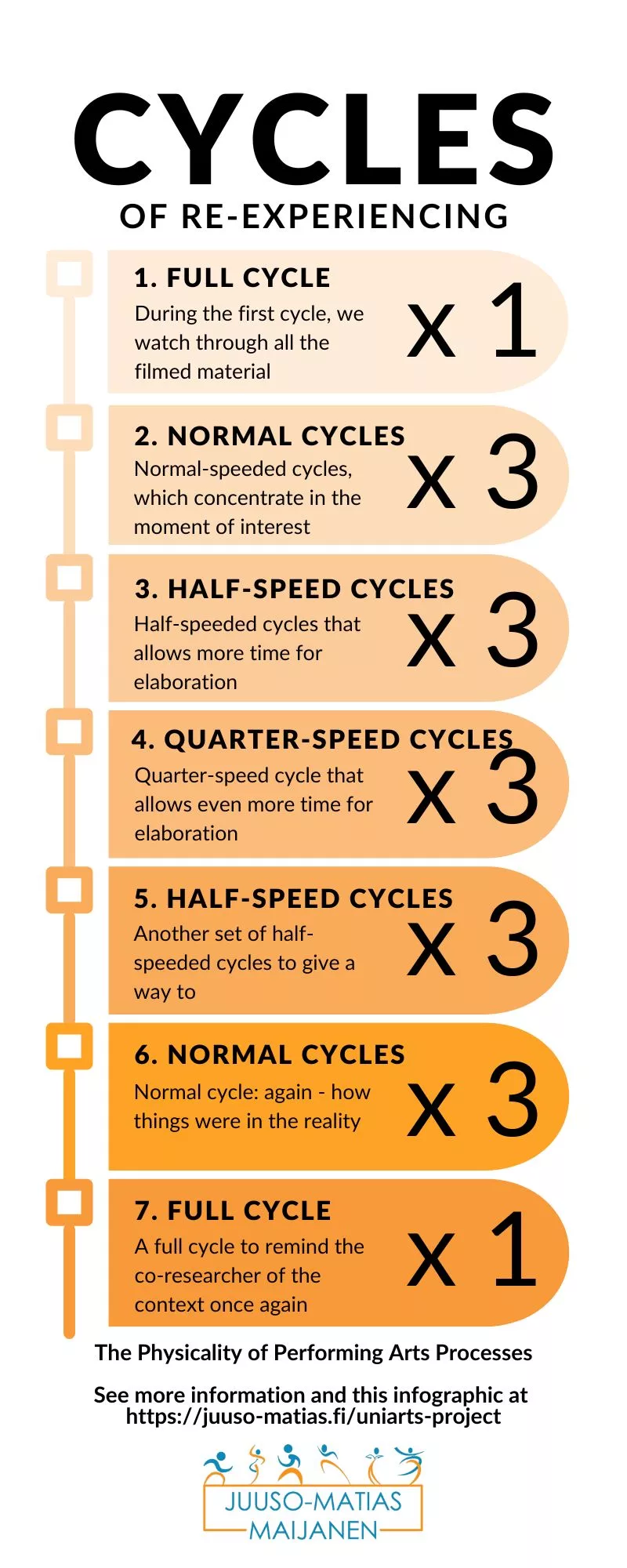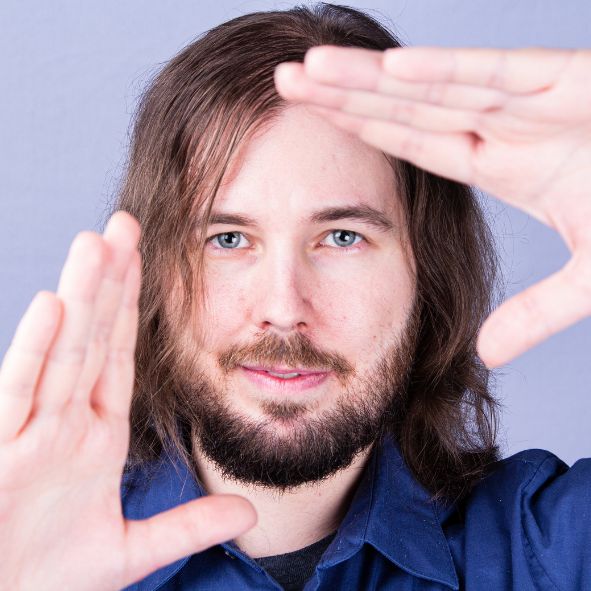Synchronized Timeline Methodology as seen on December 10th 2023
To present my idea of Synchronize Timeline, a way to link a moment of experience into a certain physical moment, I want to present it from two directions. This is a methodological direction that interplays with my idea of co-research. I will have to discuss in more detail later about this interplay between the methods, but now I will present you this methodology from two directions.
The Cycles of Re-Experiencing presents my current working theory of how the material of different timelines might be analyzed in practice. I give it in a form of a short story of a fictive co-researcher. They go through the cycles within their re-experiencing process. This is an example of how the process might present itself after a rehearsal session for someone inside the process. See also audio version recording of the same short story if that is helpful to you.
The second presentation format, section about The Technical Methodology describes the technology to create the timelines: mainly the rehearsal recording where I predict more practical challenges. It describes the practical tools through which the re-experienced material will be created and reworked with. It also sets different part of the technical process within the timeline of weekend workshops.
I have felt that I will need to plan and communicate my co-research project from experiental and experimental directions in order to include others in it. More about this can be foudn on the co-researcher side of the methodology.
The Cycles of Re-Experiencing
I put a headset on me, and it names the production, rehearsal day and time. Shows me a journey of outside the building first, and then I am teleported to the rehearsal space.
The First Cycle
I am back in the rehearsal room. It feels like a dream of a situation past. Dreams do help us learn from our experiences, to plan for the future, I mention this passing thought out aloud in order to practice vocalizing my thoughts during the watching the recording: like a commentary track! A timestamp starts at 0:00 when the first person enters the room. It was B. The rehearsal day starts as it did before. Past-me also enters and starts talking with B. B is nice. The first cycle is a full cycle.
I look at myself moving in the space, listening to the voices and reminiscing what happened, remembering the day before I came to the space. “It was a cold, misty morning then. We sat on the floor for a while.” I vocalize this. The now-me, I, smiles when the past-me is released to the floor again.
I see a timestamp highlighted for a moment. This is the moment we are to investigate specifically: the start of the first exercise. When the exercise is in full action the highlight stops. Recording of a full cycle finishes, first cycle that only repeats once. Yes. That is exactly what happened: nothing out of ordinary there. A small break for my brain.
The recording restarts from the highlighted moment of interest. I vocalize the first thing that comes to the mind. It finishes at the end of the highlight.
Cycles two to four
The second cycle repeats itself again, and I take a moment to think, not saying anything. With the third cycle, I express the coldness of the floor, something about the cold bones taking time to rev up the engine, I remember thinking of.
Things slow down at the third cycle. The moment is now frozen, or not completely frozen. Half a minute of original time slowed down into a minute. Time to vocalize in more detail, I have been told. There will still be a slower cycle too.
The moment repeats repeatedly three times. What happens? What do I experience? What did I see, what affects me? I notice a moment of thinking something else. I vocalize that: it was the funny joke I heard before about… rabbits maybe. Then I concentrate again and continue balancing the space.
The fourth cycle is about quarter-speed moments. Thirty seconds in two minutes… This time I smile at A’s expression: happy that they were in the room. They have always such a warm presence. I mention that out aloud also: it is something that exists in the space even if I was not aware of it in the moment. Might need to think of that later, thank A for it.
Returning Cycles
The fifth cycles speed up again. We go back to the half-speed. Sixth cycle is the normal speed. Seventh will let me watch the whole recording and comment on that.
Everything I say is recorded and transcribed later. Wonderful new technology.
Taking off the headset now.
It is super-interesting what can be found from what A, B and C said!
I count down in my head the cycles: 30 second, 60 second, 120 second, 60 seconds and 30 seconds times three makes… 900 seconds of condensed time. Fifteen minutes of random comments from everyone: One full hour from this group four! And naturally my comments during the full rehearsal… somebody has a lot of listening to do. Happy that it is not my role in this research! Sounds like a lot of work that must be done with care!
The Cycles of Re-Experiencing (audio recording)

The Technical Methodology
To help discuss the physicality of a process, I have chosen to use a 360-film to create a common reality. If what happens in the space is synchronized to everyone’s inner experiences, it becomes easier to understand and discuss the experiences in their complexity and in a context. I will describe more about the human side of the things when presenting the co-research methodology.
The concrete plan of action for the technical research looks as follows.
Weekend # 1: Practical measuring methodology test
- Common Timeline (recording process)
- 360-video (Insta 360 One, Insta 360 Pro, Insta360 ONE X2, Kandao Obsidian R)
- Soundscapes
- Database (Vimeo, Youtube, OneDrive)
- Timestamping
- Experience Timelines (re-experience process)
- Displays (Computer and phone, VR headsets: Meta, Daydream View and HTC Vive)
- Commentary Tracks
- Analysing the test results
- Technical Challenges
- Technical Possibilities and Restrictions
Weekend 2: Building the record-and-mirror-with-experiences framework structures.
- Testing the choices
- Mock-analysis of the data in collaboration with the working groups
- Crafting the pedagogical framework to present the co-researcher model.
Weekend 3: Testing the co-researcher framework in a real-life rehearsal setting.
- Record-Reflect Framework
After-the-weekends meetings
- 3-to-5-hour session for the internal data discussion workshop: invited to Turku for a dinner.
- 30 minutes session for the presentation of mock data and tweaking the framework as a part of an artistic research event or published as a video presentation at an online media.
I plan to synchronize the experience timelines with the help of a 360 camera, a camera that records three-dimensional pictures. We tried similar technological tools while working Love Simulation EVE and Keskiaikainen pyhiinvaellus where I noticed that these kinds of technologies can record quite accurately what all happens in the space even if they have their restrictions too. My plan is to show these films to the co-researchers and let them comment on the events and connect them with their own experiences. See the previous table for more detailed research tools and different tests I am planning on doing in order to create the process described in the first sectin.
Predicted Practical Challenges
I am predicting at least these types of challenges within the methodology.
Besides the ones I mention below, I discuss labour and respect more on the co-research side of this two-method presentation.
Human memory is limited. There are limits to the time span between rehearsal and revisiting the moment. The human brain is also sometimes unreliable: I remember things wrong, mixing memories and filling in the gaps of memory with make-believe. Key here is to avoid the build-up of fatigue by slowing down the processes and shortening the processes artificially, but also not let the rehearsal and analysis happen too far apart.
The phenomena I am studying are very complex. Human experiences, aspects of physicality in space and dynamics of human interaction are all extremely fascinating, complex phenomena. That is, I need to plan for time and labour to take the time and care to gracefully study the physicality.
The research process will also influence the actual productions people are working with, slow down and affect them. The time and labour put into the work with me is time taken away from the production. That is, any labour by my co-researchers should be compensated for.
Besides these, we are working with technology. It needs updates, maintenance, practice to use and might sometimes still not work as intended. I have to look into figuring out a few back-up plans and processes of making sure that we can make things work in a moment. This is one part of the technological testing during the process.
